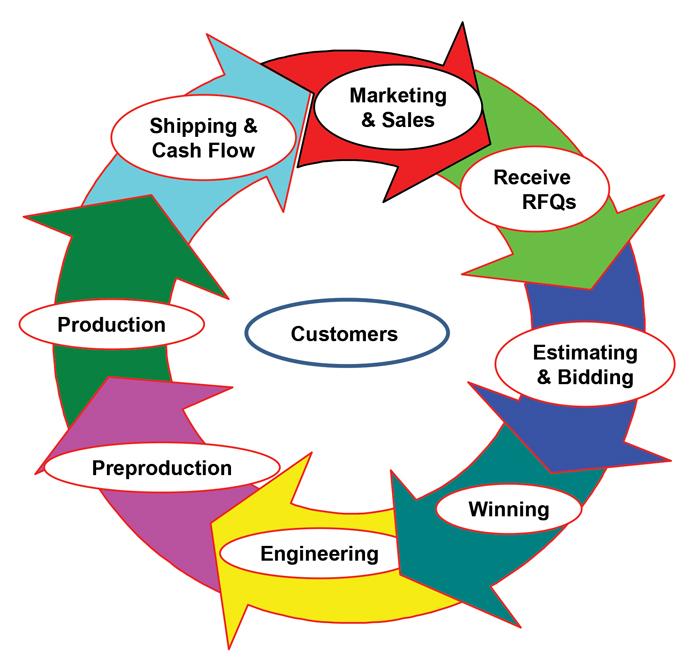President
- FMA
- The Fabricator
- FABTECH
- Canadian Metalworking
Categories
- Additive Manufacturing
- Aluminum Welding
- Arc Welding
- Assembly and Joining
- Automation and Robotics
- Bending and Forming
- Consumables
- Cutting and Weld Prep
- Electric Vehicles
- En Español
- Finishing
- Hydroforming
- Laser Cutting
- Laser Welding
- Machining
- Manufacturing Software
- Materials Handling
- Metals/Materials
- Oxyfuel Cutting
- Plasma Cutting
- Power Tools
- Punching and Other Holemaking
- Roll Forming
- Safety
- Sawing
- Shearing
- Shop Management
- Testing and Measuring
- Tube and Pipe Fabrication
- Tube and Pipe Production
- Waterjet Cutting
Industry Directory
Webcasts
Podcasts
FAB 40
Advertise
Subscribe
Account Login
Search
Want to shorten lead times?
Change the ground rules
- By Vincent Bozzone
- July 13, 2019
- Article
- Shop Management
Custom fabricators and other job shops, long hammered by intense competitive pressures to cut costs and improve quality, are now being compelled by their customers to deliver faster—in effect, to shorten lead time. It’s easier said than done, and many find they achieve few tangible results.
Why is this, exactly? We point fingers at the typical headaches, anything from workforce issues to technological mishaps. But all those are symptoms, not the root cause. So what is the root cause? The ground rules have changed and job shops haven’t adapted. If you want to make real progress in shortening your lead time—or “customer wait time,” to use a more accurate term—consider the following seven fundamental changes to your organization’s ground rules.
1. Understand Lead Time
When seeking to reduce lead time, many companies focus almost exclusively on the shop floor and ignore the rest of the organization. That is a serious mistake, as any manufacturing manager knows. For example, orders that are late coming to the shop contribute to missed ship dates but are outside the shop floor’s control. The same thing goes for defective orders; that is, orders that have inaccurate, illegible, or missing information; require material that isn’t available; or fail to reflect the latest engineering changes.
Lead time encompasses the entire time span from initial customer contact to product delivery; the shorthand for it is “quotes to cash.” You have to get beyond the shop floor to have any appreciable impact on shortening lead time. Meaningful improvements in customer wait time and shipping reliability require companywide re-evaluation that takes the entire business process into account.
2. Recognize That You’re in a Service Business
Although economists classify job shops as manufacturers, they are really a service business. Making a product to a customer’s specification is a service that just happens to come in the form of a manufactured item. You and your team might not recognize this fully, just because you focus so much on the manufacturing technology and processes employed.
And it’s not just a matter of semantics. Customers place a premium on fast service and reliability and consistent on-time delivery. Those companies that truly understand they are in a service business are best positioned to exploit speed to market as a competitive advantage.
3. Scrutinize Your Org Chart
If your organizational model looks like a traditional organization chart with lines, boxes, and divisions among functional departments, you will be frustrated in your attempts to shorten lead time. The traditional organization hierarchy is static and provides no guidance for action. The newer dynamic “organization as a process” model, which shows the series of steps required to convert quotes to cash, works much better (see Figure 1).
These steps include sales; estimating; winning bids; preproduction activities like purchasing, materials management, engineering, and scheduling; floor operations; shipping; and converting accounts receivable into cash. The problem: These functions are scattered throughout your organization and not controlled.
The whole quote-to-cash cycle really can be grouped into three basic functions: selling and bidding (the front end), engineering and preparing the won orders for production (preproduction), and producing and shipping those orders (production). If your company doesn’t have a preproduction department (and most job shops don’t), you might consider one.
This situation might sound familiar: Your press brake operator receives a job and realizes … it’s happened again. He can’t bend the job per the print with available tooling. He discusses options with his supervisor and shows the problem to engineers and customer service personnel, who call the customer for clarification. Eventually the operator receives the information he needs to perform his job successfully.
That sounds like a success story, but it’s far from it, because all that effort pushed other jobs behind schedule. If you had a preproduction department with the right resources and expertise (including knowledge of available tools and what they can accomplish), such a problematic job wouldn’t have been released to production in the first place. (Editor’s note: For more on this, see “A new look at the job shop organization chart,” archived at www.thefabricator.com.)
Establishing a department of preproduction will enable you to manage the quotes-to-cash process more effectively. That said, whatever your org chart looks like, it should allow everyone to design and manage job shop business processes so that work flows smoothly and efficiently. Teamwork across functional areas becomes the norm. In doing so, you eliminate delays and shorten lead time.
4. Know the Difference Between ask Time and Chronological Time
The focus in business traditionally has been on shortening task time because that’s paid for by the hour, and productivity (more output per hour with the same resources) has a direct bearing on profitability. Chronological time, on the other hand, refers to the process time (clock time) required to convert a customer’s order into a shipment.
The costs of chronological delays in your business processes are hidden and difficult to measure. Everyone knows what happens to profits when a company reduces labor costs. Not obvious, but every bit as important, is how many orders you lost last year because a competitor could deliver faster. You’ll never know, and those lost sales and lost profits will never show up on your income statement.
5. Actively Manage Capacity
Lead time is not fixed; it varies with your backlog. The larger the backlog, the longer the lead time will be for new orders. At the same time, you must be able to manage capacity to maintain reasonable order backlog levels and lead times when sales increase.You can use a number of strategies to expand and contract capacity to maintain or shorten lead time in the face of variable demand. A few include overtime, increasing workforce flexibility, adding shifts, and outsourcing.
6. Eliminate or Minimize Delays
You can shorten lead times by following and repeating the following process:
Examine each step in the business process, from quotes to cash.
Identify delays.
Make the delaying steps explicit.
Gain widespread involvement to review, critique, and revamp as required.
By doing this, you create a systematic way to eliminate delays permanently and minimize those that cannot be eliminated. This essential improvement process can be tedious and time-consuming, especially while running your business. Getting skillful help generally makes all the difference between success and failure. That said, one simple approach to try is to email everyone in the organization and ask them to fill in the blank, “Why does it take so long to _________?” This is a quick and dirty way to identify delays so that you can act.
7. Measure Results
You typically calculate lead time by dividing the order backlog (booked business) by average weekly shipments. For example, if your job shop has $4 million in annual revenue, that means you need to ship roughly $77,000 per week to maintain that level of revenue. If you have an order backlog worth $350,000, this would make the average lead time for new orders 4.5 weeks ($350,000 divided by $77,000). Your sales department might be quoting six, seven, even eight weeks just to be on the safe side. Or, they might quote three weeks, because they need that short lead time to get the order. Problem is, all this provides far too vague a measure if you want to provide your customers with accurate lead-time information—and lead times quoted too long can cost you sales.
A more accurate and informative method for measuring lead time is velocity, or the speed at which an order moves through your business, from order entry to shipping. To calculate velocity, determine the number of days between the order entry date and the ship date. The fewer the days, the faster the velocity. The easiest way to do this is with pure calendar time, not the number of workdays. For example, an order that was entered on Sept. 3 and shipped on Nov. 11 would have a velocity of 38 days.
Calculating order velocity as in/out time for each order provides the data you need to construct a histogram, a tool that will give you a different perspective on your lead-time performance. Figure 2 is a prime example. The graph on the left shows that 10 percent of all orders were shipped in two weeks or less with an average lead time of 40 days. The graph on the right shows improvement: 25 percent were shipped in two weeks or less with an average lead time of 34 days.
The Need for Speed
If your company aims to remain competitive in today’s business environment, you need to shorten lead time. Doing it effectively and consistently can be a powerful performance- and profit-improvement strategy that will increase sales, reduce costs, accelerate cash flow, and increase effective capacity, all at the same time.
Again, achieving shorter lead times isn’t easy. Not only do you need to change the ground rules for your organization, you need to recognize that it’s an ongoing process—not a one-time event. Everyone needs to change their thinking and maintain a disciplined approach to process improvement.
Above all, you need to recognize and manage your job shop as a service business, one that just happens to manufacture things.
The sooner and more clearly everyone understands this, the sooner your job shop can get on the fast track to profitable growth.
Companies that can respond to customers’ needs faster than their competitors will survive and prosper. Those that can’t will fall by the wayside. It’s that simple.
Vincent Bozzone is president of Delta Dynamics Inc., jobshop360.com, deltadynamicsinc.com.
About the Author

subscribe now

The Fabricator is North America's leading magazine for the metal forming and fabricating industry. The magazine delivers the news, technical articles, and case histories that enable fabricators to do their jobs more efficiently. The Fabricator has served the industry since 1970.
start your free subscription- Stay connected from anywhere

Easily access valuable industry resources now with full access to the digital edition of The Fabricator.

Easily access valuable industry resources now with full access to the digital edition of The Welder.

Easily access valuable industry resources now with full access to the digital edition of The Tube and Pipe Journal.
- Podcasting
- Podcast:
- The Fabricator Podcast
- Published:
- 04/16/2024
- Running Time:
- 63:29
In this episode of The Fabricator Podcast, Caleb Chamberlain, co-founder and CEO of OSH Cut, discusses his company’s...
- Industry Events
16th Annual Safety Conference
- April 30 - May 1, 2024
- Elgin,
Pipe and Tube Conference
- May 21 - 22, 2024
- Omaha, NE
World-Class Roll Forming Workshop
- June 5 - 6, 2024
- Louisville, KY
Advanced Laser Application Workshop
- June 25 - 27, 2024
- Novi, MI

































